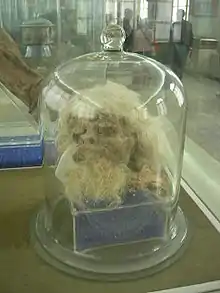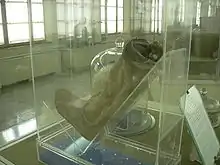

The Saltmen (Persian: مردان نمکی, mardān-e namakī) were discovered in the Chehrabad salt mines, located on the southern part of the Hamzehlu village, on the west side of the city of Zanjan, in the Zanjan Province in Iran. By 2010, the remains of six men had been discovered, most of them accidentally killed by the collapse of galleries in which they were working.[1] The head and left foot of Salt Man 1 are on display at the National Museum of Iran in Tehran.
Discovery
In the winter of 1993, miners came across a body with long hair, a beard and some artifacts. These included the remains of a body, a lower leg inside a leather boot, three iron knives, a woollen half trouser, a silver needle, a sling, parts of a leather rope, a grindstone, a walnut, some pottery shards, some patterned textile fragments, and a few broken bones. The body had been buried in the middle of a tunnel approximately 45 metres (148 ft) in length.[2]
In 2004, another salt miner found the remains of a second man. During archaeological excavations in 2005, the remains of another two well-preserved men were found. In 2006, the Iranian Cultural Heritage News Agency partnered with the German Mining Museum in Bochum (Germany), in 2007 with the University of Oxford and the Swiss University of Zurich for thorough investigations. A scientific long-term project was started, supported by Deutsche Forschungsgemeinschaft (DFG) and British funds.[1] Four corpses, including a teenager and a woman, are kept at the Archeology Museum (Zolfaghari House) in Zanjan. A sixth corpse found in the excavation campaign 2010 was left in place at the salt mine. Three hundred pieces of fabric were found, some of which retained designs and dyes. In 2008, the Ministry of Industries and Mines canceled the mining permit.[3]
Research
After archaeological studies which included C14 dating of different samples of bones and textiles, the Salt Man was dated to about 1,700 years ago. By testing a sample of hair, the blood group B+ was determined.
Three-dimensional scans which were modeled by a scientific team led by Jalal Jalal Shokouhi[4] show fractures around the eye and other injuries which occurred before death, resulting from a hard blow. Visual characteristics included long hair and a beard; a golden earring in the left ear indicated that he was likely a person of rank or influence. The reason for his presence and death in the salt mine of Chehrabad remains a mystery.
Three of the saltmen are dated to the Parthian (247 BCE–224 CE) and Sassanid (224–651 CE) eras, and the remainder to the Achaemenid Dynasty (550–330 BCE).[3]
In a 2012 research paper,[5] it was reported that the 2200-year-old mummy of Chehrabad had tapeworm eggs from the genus Taenia in his intestine. This brings new information on ancient diet, indicating the consumption of raw or undercooked meat, and it also constitutes the earliest evidence of ancient intestinal parasites in Iran, adding to the knowledge of gastrointestinal pathogens in the Near East.[5]
See also
References
- 1 2 Aali, Abolfazl; Stöllner, Thomas; Abar, Aydin; Rühli, Frank (2012). "The Salt Men of Iran: The Salt Mine of Douzlākh, Chehrābād". Archäologisches Korrespondenzblatt. Mainz: Verlag des Römisch-Germanischen Zentralmuseums. 42 (1): 61–81. ISSN 0342-734X.
- ↑ "Salt Men of Iran". Altas Obscura. Altas Obscura. Retrieved 21 June 2019.
- 1 2 "Salt men of Iran". Past Horizons. June 7, 2011. Archived from the original on May 8, 2014. Retrieved June 8, 2011.
- ↑ "بازسازی چهره اجساد نمکی در ایران". CHN. August 22, 2005. Archived from the original on April 15, 2016.
- 1 2 Nezamabadi, M; Mashkour, M; Aali, A; Stöllner, T; Le Bailly, M (Dec 15, 2012). "Identification of Taenia sp. in a natural human mummy (3rd century B.C.) from the Chehrabad salt mine in Iran". The Journal of Parasitology. 99 (3): 570–2. doi:10.1645/12-113.1. PMID 23240712. S2CID 26253984.
Sources
- Aali, Abolfazl; Stöllner, Thomas; Abar, Aydin; Rühli, Frank (2012). "The Salt Men of Iran: The Salt Mine of Douzlākh, Chehrābād". Archäologisches Korrespondenzblatt. Mainz: Verlag des Römisch-Germanischen Zentralmuseums. 42 (1): 61–81. ISSN 0342-734X.
- Hadian; Good; Pollard (2013). "Textiles from Douzlakh Salt Mine at Chehr Abad, Iran: A Technical and Contextual Study of Late pre-Islamic Iranian Textiles". The International Journal of Humanities of the Islamic Republic of Iran. Tarbiat Modarres University. 19 (3): 152–173. ISSN 1735-5060. Archived from the original on 19 July 2013. Retrieved 6 August 2013.
- National Museum of Iran, Description of the exhibits. Tehran.
- Ramaroli, V; Hamilton, J.; Ditchfield, P.; Fazeii, H.; Aali, A.; Coningham, R.A.E.; Pollard, A.M. (2010). "The Chehr Abad "Salt men" and the isotopic ecology of humans in ancient Iran". American Journal of Physical Anthropology. 143 (3): 343–354. doi:10.1002/ajpa.21314. PMID 20949607.
- Vatandoust, Abdolrasool (1998). Saltman: Scientific Investigations carried out on Saltman Mummified Remains and its Artifacts (1st ed.). Tehran: Research Center for Conservation od Caltural Relics (RCCCR). ISBN 964-91875-1-0.

